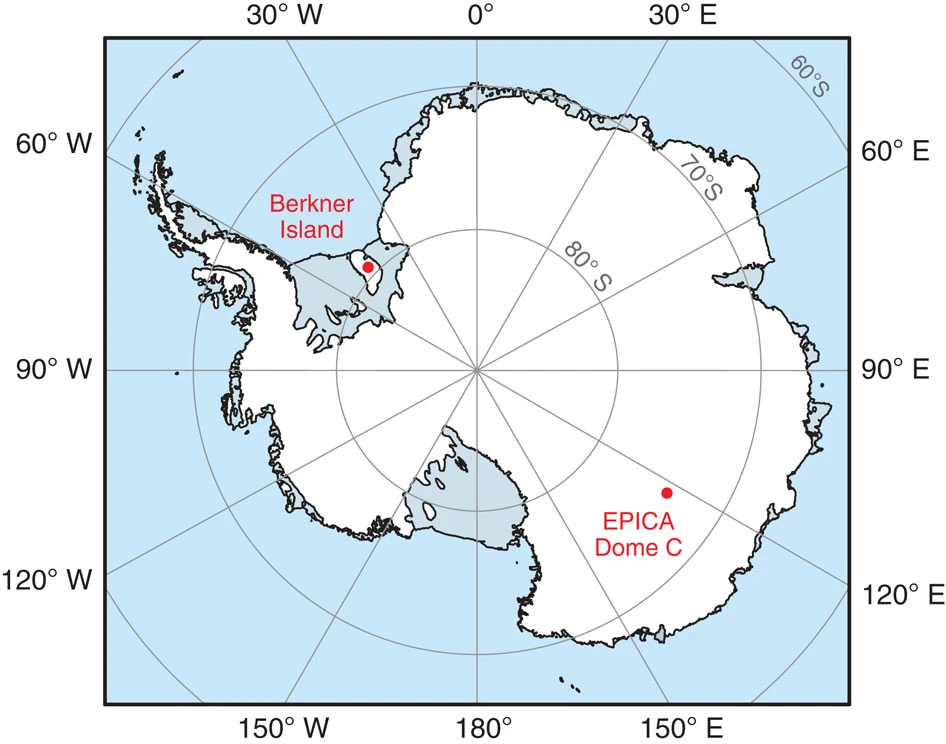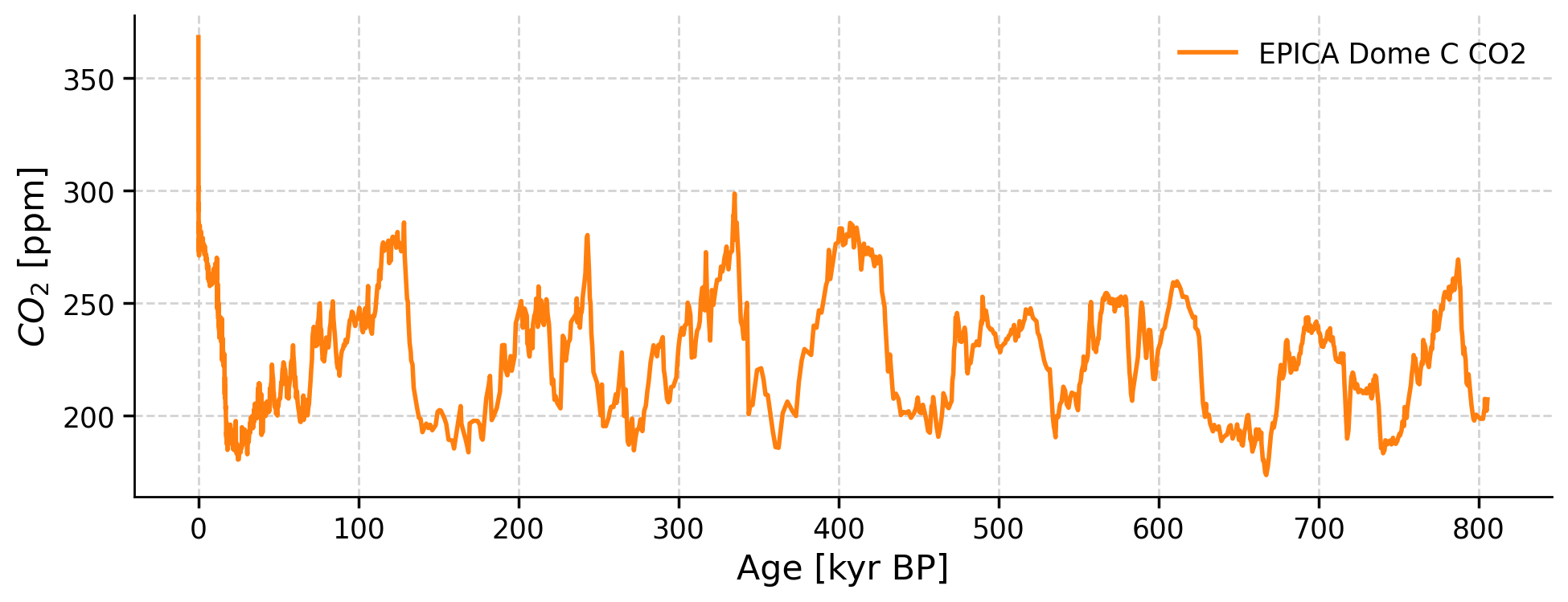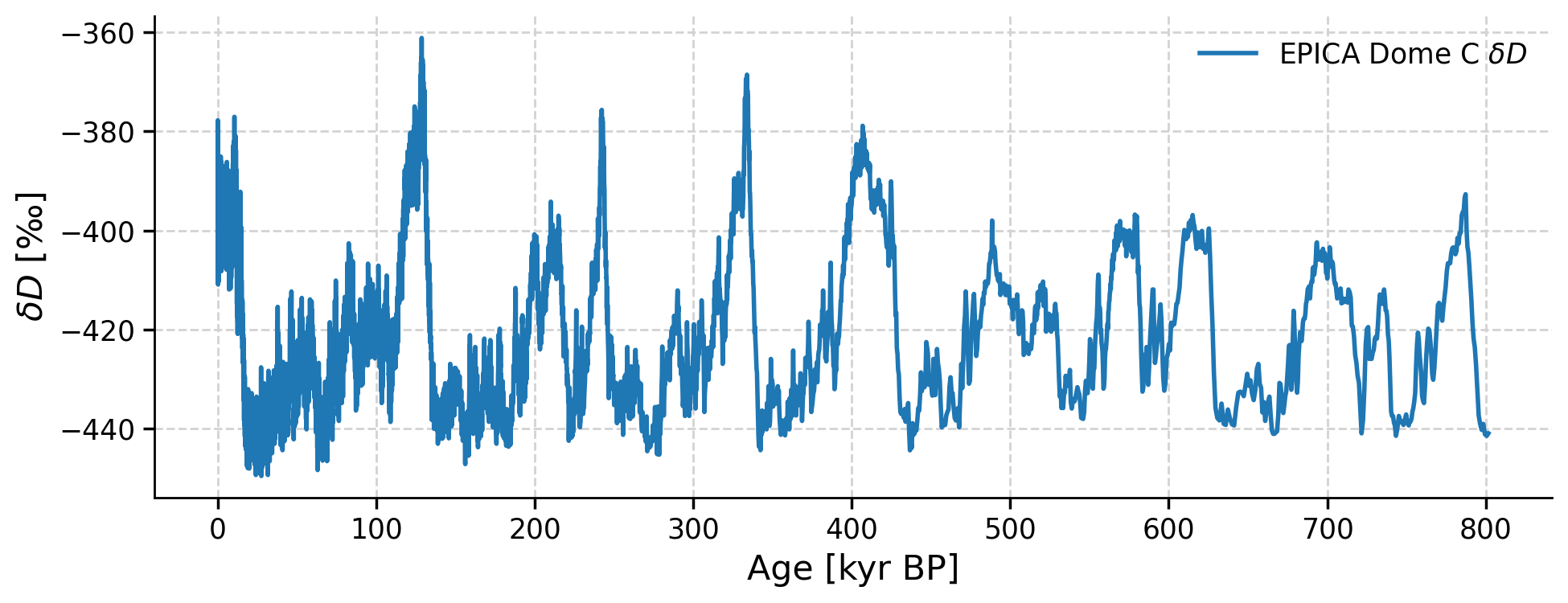Tutorial 4: Reconstructing Past Changes in Atmospheric Climate#
Week 1, Day 4, Paleoclimate
Content creators: Sloane Garelick
Content reviewers: Yosmely Bermúdez, Dionessa Biton, Katrina Dobson, Maria Gonzalez, Will Gregory, Nahid Hasan, Paul Heubel, Sherry Mi, Beatriz Cosenza Muralles, Brodie Pearson, Jenna Pearson, Chi Zhang, Ohad Zivan
Content editors: Yosmely Bermúdez, Paul Heubel, Zahra Khodakaramimaghsoud, Jenna Pearson, Agustina Pesce, Chi Zhang, Ohad Zivan
Production editors: Wesley Banfield, Paul Heubel, Jenna Pearson, Konstantine Tsafatinos, Chi Zhang, Ohad Zivan
Our 2024 Sponsors: CMIP, NFDI4Earth
Tutorial Objectives#
Estimated timing of tutorial: 20 minutes
In this tutorial, we’ll analyze δD and atmospheric CO2 data from the EPICA Dome C ice core. Recall from the video that δD and δ18O measurements on ice cores record past changes in temperature and that measurements of CO2 trapped in ice cores can be used for reconstructing past changes in Earth’s atmospheric composition.
By the end of this tutorial you will be able to:
Plot δD and CO2 records from the EPICA Dome C ice core
Assess changes in temperature and atmospheric greenhouse gas concentration over the past 800,000 years
Setup#
# installations ( uncomment and run this cell ONLY when using google colab or kaggle )
# !pip install pyleoclim
# imports
# for Google Colab users: you might get a numpy.dtype error here, restart your session and rerun the code and it should solve it.
import pandas as pd
import matplotlib.pyplot as plt
import pooch
import os
import tempfile
import pyleoclim as pyleo
Install and import feedback gadget#
Show code cell source
# @title Install and import feedback gadget
!pip3 install vibecheck datatops --quiet
from vibecheck import DatatopsContentReviewContainer
def content_review(notebook_section: str):
return DatatopsContentReviewContainer(
"", # No text prompt
notebook_section,
{
"url": "https://pmyvdlilci.execute-api.us-east-1.amazonaws.com/klab",
"name": "comptools_4clim",
"user_key": "l5jpxuee",
},
).render()
feedback_prefix = "W1D4_T4"
Figure Settings#
Show code cell source
# @title Figure Settings
import ipywidgets as widgets # interactive display
%config InlineBackend.figure_format = 'retina'
plt.style.use(
"https://raw.githubusercontent.com/neuromatch/climate-course-content/main/cma.mplstyle"
)
Helper functions#
Show code cell source
# @title Helper functions
def pooch_load(filelocation=None, filename=None, processor=None):
shared_location = "/home/jovyan/shared/Data/tutorials/W1D4_Paleoclimate" # this is different for each day
user_temp_cache = tempfile.gettempdir()
if os.path.exists(os.path.join(shared_location, filename)):
file = os.path.join(shared_location, filename)
else:
file = pooch.retrieve(
filelocation,
known_hash=None,
fname=os.path.join(user_temp_cache, filename),
processor=processor,
)
return file
Video 1: Atmospheric Climate Proxies#
Submit your feedback#
Show code cell source
# @title Submit your feedback
content_review(f"{feedback_prefix}_Atmospheric_Climate_Proxies_Video")
If you want to download the slides: https://osf.io/download/szyhp/
Submit your feedback#
Show code cell source
# @title Submit your feedback
content_review(f"{feedback_prefix}_Atmospheric_Climate_Proxies_Slides")
Section 1: Exploring past variations in atmospheric CO2#
As we learned in the video, paleoclimatologists can reconstruct past changes in atmospheric composition by measuring gases trapped in layers of ice from ice cores retrieved from polar regions and high-elevation mountain glaciers. We’ll specifically be focusing on paleoclimate records produced from the EPICA Dome C ice core from Antarctica.

Credit: Conway et al 2015, Nature Communications
Let’s start by downloading the data for the composite CO2 record for EPICA Dome C in Antarctica:
# download the data using the url
filename_antarctica2015 = "antarctica2015co2composite.txt"
url_antarctica2015 = "https://www.ncei.noaa.gov/pub/data/paleo/icecore/antarctica/antarctica2015co2composite.txt"
data_path = pooch_load(
filelocation=url_antarctica2015, filename=filename_antarctica2015
) # open the file
co2df = pd.read_csv(data_path, skiprows=137, sep="\t")
co2df.head()
| age_gas_calBP | co2_ppm | co2_1s_ppm | |
|---|---|---|---|
| 0 | -51.03 | 368.02 | 0.06 |
| 1 | -48.00 | 361.78 | 0.37 |
| 2 | -46.28 | 359.65 | 0.10 |
| 3 | -44.41 | 357.11 | 0.16 |
| 4 | -43.08 | 353.95 | 0.04 |
Next, we can store this data as a Series in Pyleoclim:
ts_co2 = pyleo.Series(
time=co2df["age_gas_calBP"] / 1000,
value=co2df["co2_ppm"],
time_name="Age",
time_unit="kyr BP",
value_name=r"$CO_2$",
value_unit="ppm",
label="EPICA Dome C CO2",
)
Time axis values sorted in ascending order
/tmp/ipykernel_127121/2608164936.py:1: UserWarning: auto_time_params is not specified. Currently default behavior sets this to True, which might modify your supplied time metadata. Please set to False if you want a different behavior.
ts_co2 = pyleo.Series(
We can now plot age vs. CO2 from EPICA Dome C:
ts_co2.plot(color="C1")
(<Figure size 1000x400 with 1 Axes>,
<Axes: xlabel='Age [kyr BP]', ylabel='$CO_2$ [ppm]'>)

Notice that the x-axis is plotted with present-day (0 kyr) on the left and the past (800 kyr) on the right. This is a common practice when plotting paleoclimate time series data.
These changes in CO2 are tracking glacial-interglacial cycles (Ice Ages) over the past 800,000 years. Recall that these Ice Ages occur as a result of changes in the orbital cycles of Earth: eccentricity (100,000 year cycle), obliquity (40,000 year cycle), and precession (21,000 year cycle). Can you observe them in the graph above?
Section 2: Exploring the relationship between δD and atmospheric CO2#
To investigate the relationship between glacial cycles, atmospheric CO2 and temperature, we can compare CO2 to a record of hydrogen isotopic values (δD) of ice cores, which is a proxy for temperature in this case. Remember, when interpreting isotopic measurements of ice cores, a more depleted δD value indicates cooler temperatures, and a more enriched δD value indicates warmer temperatures. This is the opposite relationship we have looked at previously with δ18O, not because we are looking at a different isotope, but because we are not looking at the isotopic composition of ice rather than the isotopic composition of the ocean.
Let’s download the EPICA Dome C δD data, store it as a Series, and plot the data:
# download the data using the url
filename_edc3deuttemp2007 = "edc3deuttemp2007.txt"
url_edc3deuttemp2007 = "https://www.ncei.noaa.gov/pub/data/paleo/icecore/antarctica/epica_domec/edc3deuttemp2007.txt"
data_path = pooch_load(
filelocation=url_edc3deuttemp2007, filename=filename_edc3deuttemp2007
) # open the file
dDdf = pd.read_csv(data_path, skiprows=91, encoding="unicode_escape", sep="\s+")
# remove nan values
dDdf.dropna(inplace=True)
dDdf.head()
| Bag | ztop | Age | Deuterium | Temperature | |
|---|---|---|---|---|---|
| 12 | 13 | 6.60 | 38.37379 | -390.9 | 0.88 |
| 13 | 14 | 7.15 | 46.81203 | -385.1 | 1.84 |
| 14 | 15 | 7.70 | 55.05624 | -377.8 | 3.04 |
| 15 | 16 | 8.25 | 64.41511 | -394.1 | 0.35 |
| 16 | 17 | 8.80 | 73.15077 | -398.7 | -0.42 |
dDts = pyleo.Series(
time=dDdf["Age"] / 1000,
value=dDdf["Deuterium"],
time_name="Age",
time_unit="kyr BP",
value_name=r"$\delta D$",
value_unit="\u2030",
label=r"EPICA Dome C $\delta D$",
)
Time axis values sorted in ascending order
/tmp/ipykernel_127121/432984493.py:1: UserWarning: auto_time_params is not specified. Currently default behavior sets this to True, which might modify your supplied time metadata. Please set to False if you want a different behavior.
dDts = pyleo.Series(
dDts.plot()
(<Figure size 1000x400 with 1 Axes>,
<Axes: xlabel='Age [kyr BP]', ylabel='$\\delta D$ [‰]'>)

When we observe the δD data, we see very similar patterns as in the atmospheric CO2 data. To more easily compare the two records, we can plot the two series side by side by putting them into a MultipleSeries object. Since the δD and CO2 values have different units, we can first standardize the series and then plot the data.
# combine series
ms = pyleo.MultipleSeries([dDts, ts_co2])
# standarize series and plot
ms.standardize().plot()
(<Figure size 1000x400 with 1 Axes>, <Axes: xlabel='Age [ka]', ylabel='value'>)

Now we can more easily compare the timing and magnitude of changes in CO2 and δD at EPICA Dome C over the past 800,000 years. During glacial periods, δD was more depleted (cooler temperatures) and atmospheric CO2 was lower. During interglacial periods, δD was more enriched (warmer temperatures) and atmospheric CO2 was higher.
Questions 2: Climate Connection#
Why do δD, CO2 and glacial cycles covary so closely?
Can you identify glacial and interglacial periods? Today, are we in an interglacial or glacial period?
Do the cooling and warming periods of the cycles happen at the same rate?
What climate forcings do you think are driving these cycles?
Submit your feedback#
Show code cell source
# @title Submit your feedback
content_review(f"{feedback_prefix}_Questions_2")
Summary#
In this tutorial, we dove into the captivating world of paleoclimatology, focusing on the analysis of hydrogen isotopes (δD) and atmospheric CO2 data from the EPICA Dome C ice core. This involved understanding how δD and δ18O measurements from ice cores can enlighten us about past temperature changes, and how trapped CO2 in these ice cores can help us reconstruct shifts in Earth’s atmospheric composition.
By the end of the tutorial, you should be comfortable with plotting δD and CO2 records from the EPICA Dome C ice core and assessing changes in temperature and atmospheric greenhouse gas concentrations over the past 800,000 years. In the next tutorial, we’ll introduce various paleoclimate data analysis tools.
Resources#
Code for this tutorial is based on an existing notebook from LinkedEarth that explores EPICA Dome C paleoclimate records.
Data from the following sources are used in this tutorial:
Jouzel, J., et al. Orbital and Millennial Antarctic Climate Variability over the Past 800,000 Years, Science (2007). https://doi.org/10.1126/science.1141038.
Lüthi, D., Le Floch, M., Bereiter, B. et al. High-resolution carbon dioxide concentration record 650,000–800,000 years before present. Nature 453, 379–382 (2008). https://doi.org/10.1038/nature06949.
Bereiter, B. et al., Revision of the EPICA Dome C CO2 record from 800 to 600 kyr before present, Geoph. Res. Let. (2014). https://doi.org/10.1002/2014GL061957.


